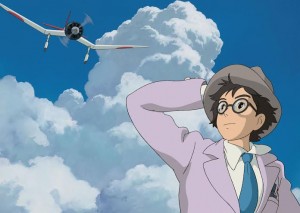‘The Wind Rises’ soars above expectations
Hayao Miyazaki has captivated audiences around world with dramatic yet light-hearted storytelling and enchanting animation. Within a two-hour animated film, Miyazaki weaves a tale of romance, history and an assortment of aviation eye-candy.
In contrast with his previous child-friendly movie, Ponyo, Miyazaki’s latest animated film gives rise to a historical drama based on a blend of both Tatsuo Hori’s short story “The Wind Has Risen” and the designer of the A6M Zero, Jiro Horikoshi. The animated feature follows the fictional life of Jiro Horikoshi as he aspires to design the world’s most beautiful airplanes. His passion for aviation influences his recurring dreams with his personal hero Caproni, the famous Italian aeronautical engineer. Initially, Jiro’s dream to pilot airplanes was metaphorically crushed by his nearsighted vision. Yet this limitation never stopped him as he finds other means to channel his fascination for aeronautics. Interestingly, it is Jiro’s imagined version of Caproni that lights Jiro’s inspirational candle to create airplanes. Immediately after Jiro receives inspirational words to follow his dreams, he buries himself in his studies of an English aviation magazine under candlelight.
Of course, one of the most extraordinary aspects for every Miyazaki film is attention to detail with every animation frame. Miyazaki, along with his team of talented animators, undergoes great pains to take audiences to an interactive world where the audience can feel the cold sensation of metallic surfaces by sight alone. During Jiro’s tour to Germany, he surveys a Junkers G38 and the microscopic detail of the plane’s ridges and rivets overwhelm the human eyes, leaving it unable to blink in fear of absorbing too little information before the camera pans away. Another scene worth mentioning is the initial earthquake, the low rumbling of which numbed and deafened ears as the uprooted earth swallowed vision. The crying earth screamed as it tore to pieces and houses crumbled as they were ripped from their foundations. Words fail to describe the trauma experienced by audience members as they watch the horror unfold on the screen.
World famous animator and film director, Hideaki Anno, provides the monotonous voice of the movie’s hero. Despite criticism, Anno’s unchanging inflections create a realistic personality for Jiro that audiences can relate to. Instead of an actor repeating well-rehearsed lines, Anno portrayed Jiro with such realistic sincerity that the audience quickly adjusts to his unusual style of vocal delivery. Anno’s voice made Jiro more believable as a character, as his passions could clearly be read despite his muted demeanor. Overall, Anno’s lethargic rhetoric was indeed very characteristic of Jiro, who is portrayed as a remarkably normal person imbued with an interest in aeronautics.
Surprisingly, the most amiable aspect of The Wind Rises was not the animation but how it addresses the subjective and controversial topic of art itself. The audience can sympathize with Jiro, a blindly enthusiastic artist, who pushes through long nights to design a flyable aircraft despite his continual failures. Similar to how Jiro built his planes out of sheer appreciation, Miyazaki creates his films out of sheer passion to plant the seeds of inspiration around the world. The movie reflects the personal sacrifices and risks of being too involved in artistic fervor. These passions manifest in Jiro’s workaholic personality where he places his work above spending time taking care of his wife. At the same time, Jiro’s naivety is a result of his devotion to his dreams. While Jiro is in the middle of Nazi Germany observing the new Junkers G. 38, he seems oblivious to the destructive capabilities of the plane even as his friend reminds him of the amount of arsenal the plane can carry. Throughout the film, Jiro’s fixation on airplanes has left him ignore his descent into military affairs as he focuses on designing flyable works of art.
But to many critics, Jiro’s occupation as a World War II fighter designer overshadows his innocent desire to create stunning and innovative airplanes. The movie sparked controversy both in and outside of Japan as critics accused Miyazaki of asserting a pro-war message by glorifying the man who designed military aircraft. Yet this is an entirely misconstrued interpretation of Jiro’s character and the overall message of the movie. Ultimately, Jiro’s dreams and education bring him to work for the Japanese government because it was the only viable compromise to express his abilities and make a living. He reaches his goal of building magnificent airplanes but unfortunately his art was used as a tool of war. Miyazaki intended for this film to be a reflection his own dedication as an artist, where his passions have led him to let the time and his own work slip out of his hands and into the control of others. Lost in his own dreams of inventing goliath airplanes, he slowly drowns out the events occurring in the rest of the world, seemingly unfazed by anything other than his work and his wife.
Certainly, the historical backdrop of World War II in context is merely an allusion to blurred lines between artistic invention and innovation for personal satisfaction and for militarism. Working for the Japanese government was the only method of making money and attaining his dream at the same time. Jiro has no intention of developing for the purpose of nationalistic pride; he just happened to build Japan’s most deadly fighter planes. Despite Jiro’s brilliance, his naive obsession to design aircrafts blinds him from the changing world around him until it’s too late and can no longer take back the destruction his creations have caused.
The film’s underlying message in The Wind Rises is portrayed no differently than Miyazaki’s previous fantasy films. Although Jiro is able to achieve his goal, he solemnly shows remorse over the use of his art as weapons of mass destruction. Similarly to Jiro’s own aspirations to make beautiful airplanes, Miyazaki’s purpose in creating The Wind Rises is simply because he wanted to make something beautiful.


